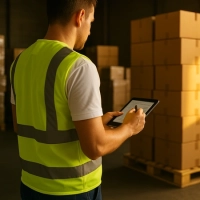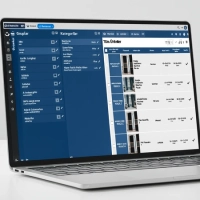
- 1. Is Your Site Really About Sales?
- 2. Product Pages: Your Digital Sales Consultant
- 3. Reducing Cart Abandonment Rate Increases Your Profits
- 4. Social Media Is No Longer a Showcase, It's the Store Itself
- 5. Re-Engage Your Customer with Email Marketing
- 6. Make Trust Elements Visible
- 7. Sell with Content, Don't Write Content to Sell
- 8. Data-Driven Decision Making: The Real Fuel of E-Commerce
- 9. Build Your Brand on Experience
- 10. Continuously Improve, Because the Digital World Does Not Stop
- Conclusion: Sales Are Not Numbers, They Are the Natural Outcome of Strategy
1. Is Your Site Really About Sales?
A website can be beautiful, but not everything beautiful sells.
Design is only the visible side of e-commerce; sales itself is the product of an invisible system.
When a visitor enters your page, they make a decision within seconds: “Is this site reliable?” “Can I easily find what I’m looking for?” “Is this brand worth paying for?”
Your answers to these questions determine your sales figures.
Guide the user with a fast-loading, simple, and intuitive site structure, a powerful search function, clear category organization, and eye-catching calls to action (CTAs).
Design the mobile experience as a standalone priority , not as a desktop priority.
Because today, the majority of e-commerce traffic comes from mobile devices.
As Comwize, we evaluate the design in terms of “transformation” before aesthetics in every e-commerce project.
A page may look nice, but what matters is that it serves sales.
2. Product Pages: Your Digital Sales Consultant
In a physical store, the sales representative explains the product, gives confidence and convinces the customer.
In e-commerce, your product page takes on this role. Photos, descriptions, reviews, pricing, and the product story—all together, they form a "chain of persuasion."
Product descriptions should be short, simple and informative, but supported by emotional triggers.
The user may already know what the product does, but they want to know why they should buy it from you .
If possible, the photos should be professionally shot; the product should be shown in detail from different angles.
The comment section is not a passive zone, it is a sales engine — actively promote it.
At Comwize, we treat each product page as a single “mini-campaign.”
Each page is an independent sales potential.
3. Reducing Cart Abandonment Rate Increases Your Profits
The visitor added a product, reached the payment stage, and then left.
Everyone goes through this — but some brands bring that customer back.
If the cart abandonment rate is high, the problem may not be with you, but with the process.
Most of the time, users don't give up on purchasing, they just postpone it.
So the system should remind them.
· Send cart reminder emails.
Use personal messages like “This product is still waiting for you.”
· Show shipping and return information upfront; don't damage trust with surprise fees at the last step.
· Allow payment via guest login.
With a simple yet effective strategy, you can regain more than 20% of abandoned carts.
And it costs much less than acquiring new customers.
4. Social Media Is No Longer a Showcase, It's the Store Itself
Social media is the most powerful stage of e-commerce.
However, most brands use this space solely as a “sharing” tool.
However, the user wants to see a story , not an advertisement.
Explain the ideas behind the product, the production process, and customer experiences.
Share real reviews from real people.
Choose sincere narratives over stunning visuals.
At Comwize, we focus on three concepts to transform social media into a sales channel:
Consistency, trust and interaction.
Consistent language introduces the brand, trust keeps the brand alive, and interaction turns into sales.
When planned correctly, a post is not just an interaction, it is the first step towards a sale.
5. Re-Engage Your Customer with Email Marketing
Finding new customers is difficult, but retaining existing customers is much more valuable.
Email marketing is the most powerful tool for achieving this balance. But many brands still rely on mass mailings. Email, however, is a personal space; it should speak to individuals, not masses.
Create special campaigns based on the user's shopping history, interests, and behavior.
Messages like “This product is for you” or “There’s a new deal in your favorite category” can convert an email into a sale.
Email strategies developed by Comwize separate customer data into smart segments to deliver the right message to the right person at the right time .
The result isn't just more emails opened; it's more completed purchases.
6. Make Trust Elements Visible
Most e-commerce users evaluate you , not just the product, before purchasing.
If there is no trust in the brand, even a discount will not translate into a sale.
The ways to build this trust are simple but have a big impact:
Use an SSL certificate and make secure shopping statements visible.
· Share clear contact information.
· State your return processes clearly.
Include real customer photos.
· Tell your brand story — people buy from people, not brands.
In Comwize's e-commerce projects, every trust element is designed as part of the user experience.
Because in the digital world , trust comes before sales.
7. Sell with Content, Don't Write Content to Sell
Content marketing is e-commerce's silent but most enduring weapon. Whether it's a blog post, a guide, or a product comparison, when structured correctly, it becomes the most effective tool for driving users to sales.
Answer the user's questions. Provide information without creating sales pressure.
Highlight your solution , not your brand, in your content.
Guide content such as “How to do it?”, “Which one is the best?”, “What should I pay attention to?”
It doesn't just drive traffic, it builds trust.
As Comwize, instead of talking about the brand in every content production, we prefer to explain what the brand adds to people .
Because knowledge creates trust, and trust turns into sales.
8. Data-Driven Decision Making: The Real Fuel of E-Commerce
Data, not intuition, speaks now.
Why was a campaign successful?
On which page did users leave the site?
Which devices generate more sales?
The answers to these questions are in the data — but collecting the data is not enough, you have to read it .
Analytical tools clearly show where sales are won or lost.
In this way, brands can direct their budgets to the right areas.
Comwize doesn't just measure data; it makes sense of it.
He considers each sales report as a step in the future strategy.
Because growth in e-commerce is achieved through proof , not guesswork.
9. Build Your Brand on Experience
Many brands say they “sell products”, but people buy experiences.
A user makes a decision based on how they feel, not just on price.
Your brand's language, visual tone, and customer communication—it all adds up.
A consistent story strengthens trust.
Brands that offer the same experience at every touchpoint create a lasting community in the long run.
Comwize doesn't just place brands on the digital showcase;
designs experience flows that engrave them in the user's memory .
Because sales may be instantaneous, but brand perception is permanent.
10. Continuously Improve, Because the Digital World Does Not Stop
There is no such thing as “complete” in e-commerce.
Technology, algorithms, and user habits are constantly changing.
Successful brands don't just follow this change; they shape it.
Constantly test your site, campaigns, and content.
Run A/B tests and you'll see that small changes can make a big difference.
Innovation in the digital world is not just about being noticed; it is about getting ahead.
This is Comwize's approach:
E-commerce is not a destination, it is a dynamic process.
We extract insight from every data for a better experience every day.
Conclusion: Sales Are Not Numbers, They Are the Natural Outcome of Strategy
Increasing e-commerce sales is not possible with a single campaign or discount;
It is possible to establish a cycle of strategy, experience and trust.
Successful brands don't sell products — they deliver value.
Understand your user, build trust, and personalize the experience.
From SEO to social media, email to analytics, unify every step towards a single goal: sustainable growth.
As Comwize, we use sales increase strategies in e-commerce not only as a marketing tool,
We consider it as an integral part of brand building .
Every brand carries a story; we make that story visible, powerful and profitable in the digital world.
Real sales growth starts with the right strategy , not with numbers.
And that strategy is the only way to carry your brand into the future.

























